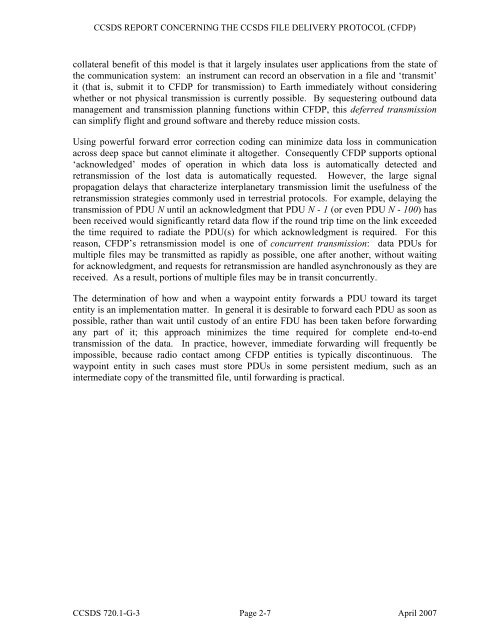CCSDS File Delivery Protocol (CFDP)âPart 1: Introduction and ...
CCSDS File Delivery Protocol (CFDP)âPart 1: Introduction and ...
CCSDS File Delivery Protocol (CFDP)âPart 1: Introduction and ...
Create successful ePaper yourself
Turn your PDF publications into a flip-book with our unique Google optimized e-Paper software.
<strong>CCSDS</strong> REPORT CONCERNING THE <strong>CCSDS</strong> FILE DELIVERY PROTOCOL (<strong>CFDP</strong>)<br />
collateral benefit of this model is that it largely insulates user applications from the state of<br />
the communication system: an instrument can record an observation in a file <strong>and</strong> ‘transmit’<br />
it (that is, submit it to <strong>CFDP</strong> for transmission) to Earth immediately without considering<br />
whether or not physical transmission is currently possible. By sequestering outbound data<br />
management <strong>and</strong> transmission planning functions within <strong>CFDP</strong>, this deferred transmission<br />
can simplify flight <strong>and</strong> ground software <strong>and</strong> thereby reduce mission costs.<br />
Using powerful forward error correction coding can minimize data loss in communication<br />
across deep space but cannot eliminate it altogether. Consequently <strong>CFDP</strong> supports optional<br />
‘acknowledged’ modes of operation in which data loss is automatically detected <strong>and</strong><br />
retransmission of the lost data is automatically requested. However, the large signal<br />
propagation delays that characterize interplanetary transmission limit the usefulness of the<br />
retransmission strategies commonly used in terrestrial protocols. For example, delaying the<br />
transmission of PDU N until an acknowledgment that PDU N - 1 (or even PDU N - 100) has<br />
been received would significantly retard data flow if the round trip time on the link exceeded<br />
the time required to radiate the PDU(s) for which acknowledgment is required. For this<br />
reason, <strong>CFDP</strong>’s retransmission model is one of concurrent transmission: data PDUs for<br />
multiple files may be transmitted as rapidly as possible, one after another, without waiting<br />
for acknowledgment, <strong>and</strong> requests for retransmission are h<strong>and</strong>led asynchronously as they are<br />
received. As a result, portions of multiple files may be in transit concurrently.<br />
The determination of how <strong>and</strong> when a waypoint entity forwards a PDU toward its target<br />
entity is an implementation matter. In general it is desirable to forward each PDU as soon as<br />
possible, rather than wait until custody of an entire FDU has been taken before forwarding<br />
any part of it; this approach minimizes the time required for complete end-to-end<br />
transmission of the data. In practice, however, immediate forwarding will frequently be<br />
impossible, because radio contact among <strong>CFDP</strong> entities is typically discontinuous. The<br />
waypoint entity in such cases must store PDUs in some persistent medium, such as an<br />
intermediate copy of the transmitted file, until forwarding is practical.<br />
<strong>CCSDS</strong> 720.1-G-3 Page 2-7 April 2007

















